Fantastic Four(ays): Fantastic Four #1 Review
Marvel's first Silver Age super-team subverts the genre in this origin issue, even if their motivations are somewhat underdeveloped
—by Nathan on February 25, 2024—
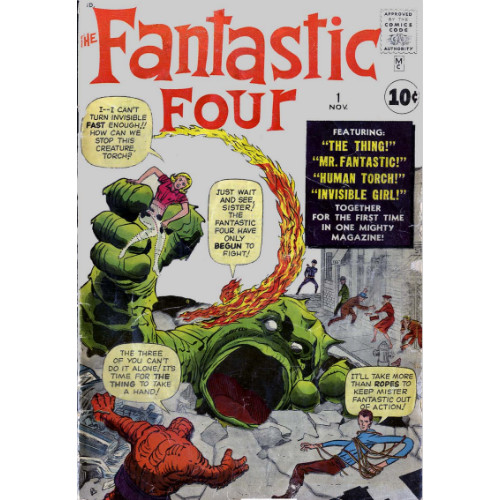
Years ago, my parents gifted me for Christmas a DVD/CD containing forty years' worth of Amazing Spider-Man comics. I still have them in digital format; I actually use photos of the PDFs for images in many of my "Spider-view" and "Crawling Back" posts. Around the same time, my dad also picked up digital collections of The Fantastic Four, The Incredible Hulk, and Silver Surfer. Each of these collections are composed of issues stemming from their respective series' creations in the 1960s to about 2006, around the time Marvel kicked off their Civil War crossover.
As I've been digging through older Amazing Spider-Man issues, I found my mind drifting towards the other collections, particularly as I considered certain storylines I'd like to cover. The "problem" with reviewing only specific arcs (like, for example, Stan Lee and Jack Kirby's "Galactus Trilogy" in Fantastic Four #48-50) is that I'm naturally driven to wanting to understand the context with each story, leading me further into a series' publication history. Why read and review one story when I can review two or three? Eventually, I began wondering, Why not start at the beginning? Much like I've reviewed some very early Spidey issues through "Crawling Back," why not do the same with some of these early Stan Lee/Jack Kirby creations?
I noted in my Amazing Fantasy #15 review that I had "ulterior motives" for reviewing that issue at that specific time, other than wanting to kick off 2024 by reviewing Spidey's very first appearance. Those "ulterior motives" were to push me towards starting this series, reviewing Fantastic Four issue-by-issue, as well as two others I plan to introduce where I'll do the same for The Incredible Hulk and Silver Surfer. Since I recently reviewed the first-ever issue of Amazing Spider-Man, this seemed like the right opportunity to review the first-ever issues of these other series.
These posts will be random–unlike other series I've started where I'm more specific about the order I release blogs, I'm just working through each issue, one-by-one, for each of these series. I can't promise the release schedule will be super consistent as I'm juggling five other series on top of these additional three. I almost see these as "filler" blogs for now, reviews I hope to write as time allows and post when I have "gaps" between other reviews I'm currently working on. It's much easier to read and review a single issue than it is an entire arc.
Please join me on this new stage in my adventures through the world of comics, the Marvel Universe specifically. And what better way to kick off a new adventure than by exploring the origins of Marvel's first family:
"The Fantastic Four"
Writer: Stan Lee
Penciler: Jack Kirby
Inkers: George Klein, Christopher Rule
Colorist: Stan Goldberg
Letterer: Artie Simek
Issue: Fantastic Four #1
Issue Publication Date: November 1961
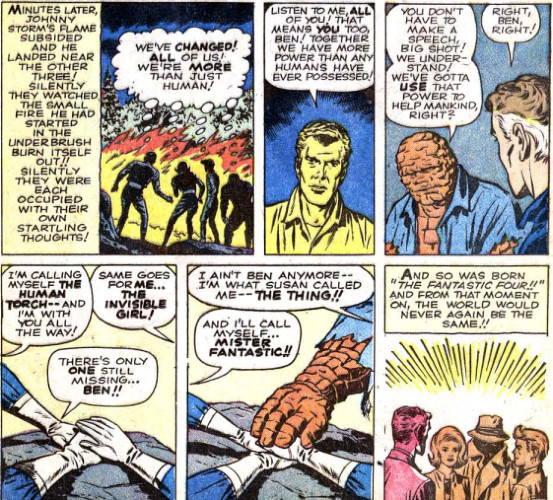
Premiering nearly a full year before their buggy buddy, the Fantastic Four promised a new era of storytelling: created to compete with DC's Justice League, the FF were superheroes done the way Stan Lee wanted them done. So what you don't get is a bunch of costumed people charging an intergalactic starfish. You can tell from the cover alone what you are getting: four people in casual clothing–three men, one woman–facing a giant subterranean monstrosity. You don't have world-renowned superheroes who have decided it's better to face together the threats they can't handle alone. You've got a craggy orange monster, a guy on fire, a dude with a bunch of rope, and a woman who seems pretty helpless as she's suspended by the subterranean monstrosity.
This is Marvel's "first family"?
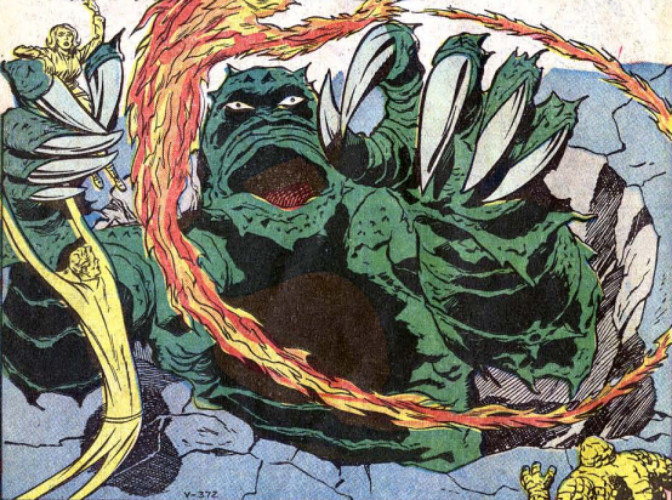
With the Fantastic Four, the human and inhuman collide, creating heroes who laugh in the face of every trope introduced until then. I've complained about Lee's writing chops before, but he was a wizard at developing characters. Why create another hero everyone adores when you can create a hero who dresses like an arachnid and is hated by everyone? Why develop a team of heroes who become instant celebrities when you can develop a team of misfits hunted by humanity and shunned for their abilities? Lee flips the script at every opportunity. Coming out of an age dominated by science fiction and monster comics, Lee concocts a team where a monster is a central cast member, where a stab at space exploration leads to a disastrous accident which irrevocably alters the lives of four people. These Fantastic Four folks are weird, and you need look no further than the first appearances of three of the four to see that:
The Invisible Girl knocks people down and freaks out a cab driver.
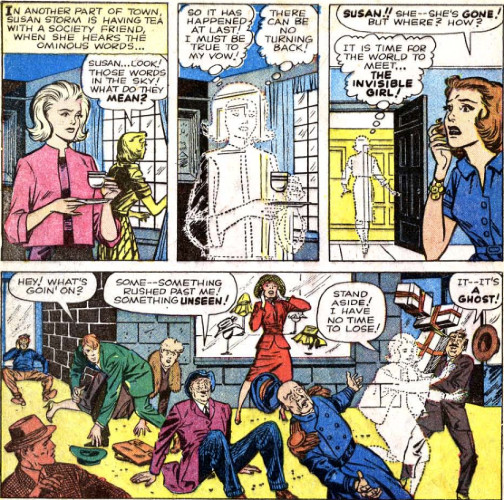
The Thing busts out of a clothing store.
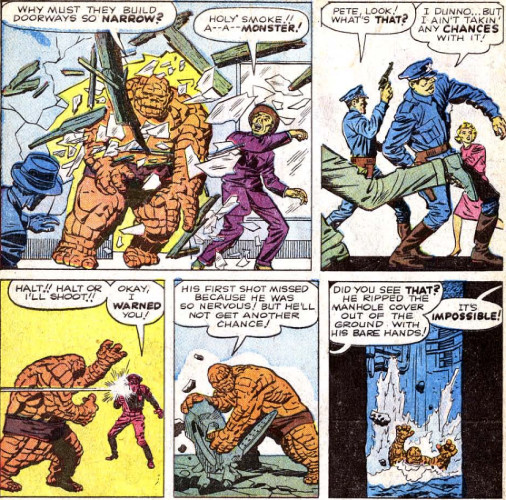
The Human Torch burns through a car and almost gets shot out of the sky by the military…
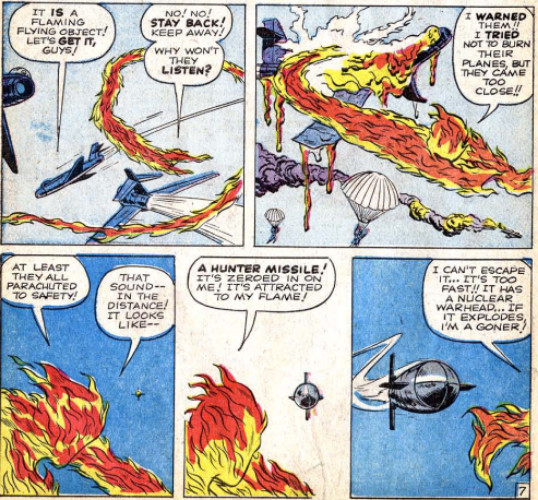
Reed Richards, the arrogant jerk, spares himself any embarrassment, letting his friends take their lumps. What a pal.
This is Marvel's "first family"?
The flash, bang, bravado of your general superhero comics is gone. These folks don't have costumes (yet), they refer to each other by their real names as often as they do their monikers. Lee throws in one of his patented love triangles the first chance he gets, but the Reed Richards/Sue Storm/Ben Grimm tension feels a tad more navigable than whatever inanity he tried concocting between Peter Parker, Betty Brant, and Ned Leeds or Matt Murdock, Karen Page, and Foggy Nelson. This is where, as I indicated, humanity and inhumanity collide. Even before their transformations, Lee creates tension within the group–Ben's stubborn demeanor causes him to question Reed, which Sue interrupts by insulting Ben, who then responds defiantly with a touch of masculine bravado. Though the scene is brief, Lee and Kirby hint at the fact these four aren't a well-oiled machine even without (excuse the expression) fantastic abilities…you get a sense that, even with their newfound powers, those tensions and imperfections won't cease.
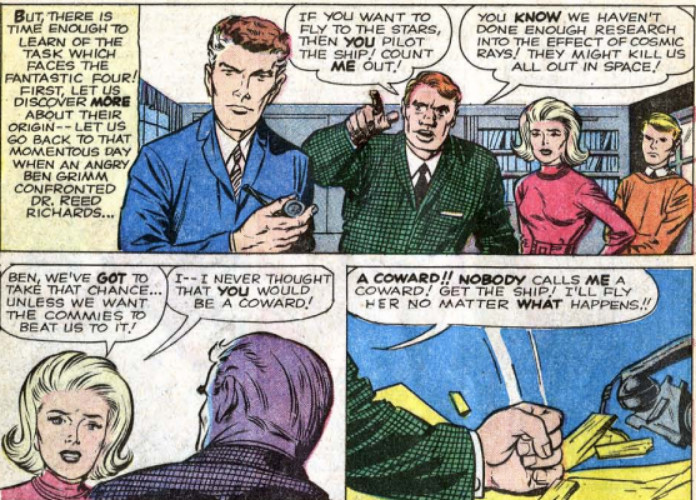
Once they encounter the cosmic rays, you recognize these people aren't regular folks anymore. Ben looks nothing like a human, Johnny bursts into flame when he gets excited, Susan can vanish (and I'll note how better writers than I have identified her invisibility powers as an application of her gender), and Reed is a walking pretzel. Yet, despite the physical changes, you also recognize their very human personalities and identities have not changed. Upon transforming into an orange rock monster, Ben takes a swing at Reed, the FF's leader only saving himself from the battering by stretching away. Ben's anger towards Reed regarding his condition–a long-standing source of tension in the title–is hinted at here. Much like you wouldn't think a guy dressed as a spider could be a hero, you wouldn't think a bulky monster or a man covered in fire could do much saving either. Lee and Kirby are here to prove you wrong, to reveal the "human" within each "superhuman."
Yes, this is Marvel's "first family."
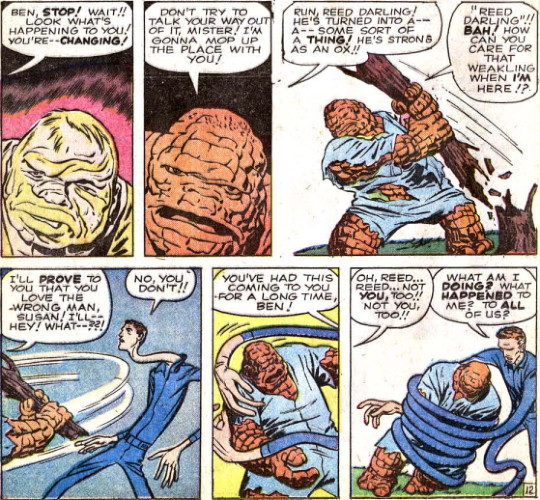
The Four are juxtaposed with this issue's villain, the enigmatic Mole Man, a figure of curious appearance, scorned by the surface world, who fell into a subterranean world of monsters which he took command of, despite losing his sight. Much like the FF, he's an individual whose life is forever altered by the capricious hand of fate. Yet where the FF, undaunted by their conditions, choose a nobler path, the Mole Man has (appropriately) descended into his own self-pitying state and declared war on humanity. His plans are (naturally) thwarted, his gargantuan monsters providing much of the issue's physical conflict yet also allowing Lee and Kirby to introduce brief philosophical content. There's something to be said about a man condemned to darkness seeking to (in his words) "destroy everything that lives above the surface!" Shunned by humanity, at home with monsters he cannot even see (and, most likely, relates to as an outcast himself), the Mole Man seeks revenge. Though Doctor Doom would later become the FF's opposite number (particularly Reed Richards'), Lee and Kirby's forethought in developing a character uniquely similar yet contrary to the Fantastic Four should be noted.
"Can we make heroes out of monsters?" the issue asks, and it convincingly shows readers it can. "Why should monsters become heroes?" is another question flitting through the panels, and it's this inquiry which the issue struggles to answer. After the Four discover their abilities, Reed notes how much more powerful they are than other people. Ben interrupts, getting to the heart of Reed'"s suggestion: "We’ve gotta use that power to help mankind, right? Nowhere is the word "superhero" used, but considering the group each takes on a colorful moniker immediately afterward, that seems to be the conclusion each member reaches simultaneously. Though Lee and Kirby do unpack the Four's reactions to their incredible circumstances, the transition from "We were just blasted by cosmic radiation that's fundamentally altered our DNA" to "We’re gonna be superheroes" is a tad fast.
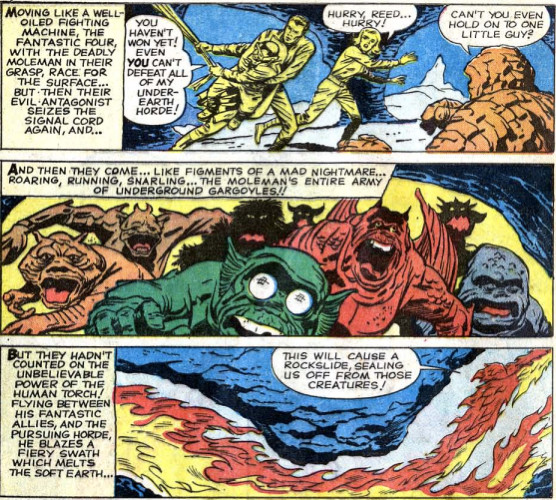
You may point out that, since the issue forgoes other common trappings of the genre such as flashy costumes (for now) or a headquarters (for now), that Lee and Ditko are attempting to subvert the genre. As I've discussed already, I would agree. I think it's one reason why those established elements from sci-fi and monster comics find home here–Lee and Kirby offer some familiarity to readers rather than immediately throwing them into a world of costumed heroes and villains. By blending these genres, the creators present the FF as adventurers and explorers first, superheroes second. It's just their explorations often lead them to protect and defend others.
To me, the struggle in accepting Ben's proclamation is that sudden, immediate shift to altruism after their alterations. I feel anyone would need time to process such a transformation. Lee and Steve Ditko's introduction of Spider-Man months later revolved around the young man seeking financial gain from his powers–adopting his costumed identity was just a way for Peter to maintain a secret, and I would argue that it's only by the second issue of Amazing Spider-Man that Lee and Ditko present a Peter Parker fully indoctrinated in the "superhero" mode of thinking. I wish some of the same existed for the FF. Ben's no dummy, and Reed's a genius, but answering the question of what these four will use their powers for isn't like solving a math or science problem. There are deeper considerations I wish this issue addressed.
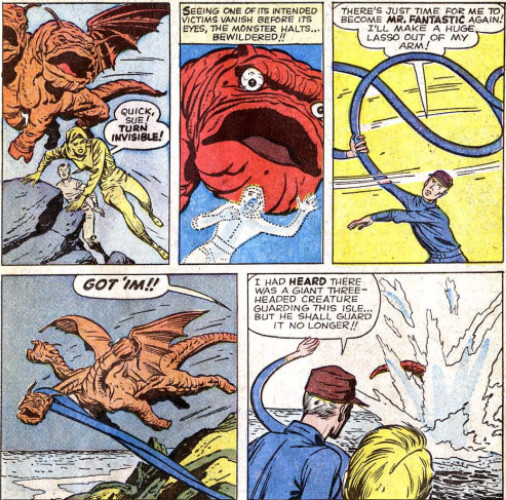
Still, this is Marvel's "first family."
This issue is the blueprint upon which the next six decades of Marvel history is constructed. You got your somewhat socially estranged superheroes who choose to remain together, united by circumstances and emotional connections. The FF aren't ostracized like the X-Men, but few people can get over the orange rock-man lumbering through their midst. They're oddballs, biological outcasts, who bicker with each other almost as much as they battle bad guys. That's the human element echoing through each character. The FF's decision to use their abilities for the benefit of mankind is awkwardly executed, but that's why this issue is a "blueprint." Over time, Lee and Kirby will construct a house from the ideas planted, which will grow to shape the contours of the family living inside (important when your pater familias can stretch like Reed Richards). And there will be more houses from this blueprint, a whole neighborhood expanding to Forest Hills and Hell's Kitchen, sculpted as necessary to create the first heroes in the burgeoning Marvel universe. Isn't it fantastic seeing what all came from the introduction of one family?
Here's hoping Marvel doesn’t screw up their MCU debut.